SOE11144 - Brexit's Impact on the UK Automotive Industry & Nissan
VerifiedAdded on 2023/05/27
|15
|3701
|71
Project
AI Summary
This project provides an in-depth analysis of the potential impacts of Brexit on the UK's automotive industry, with a specific focus on Nissan. It begins by outlining the importance of the automotive sector to the UK economy and its close integration with the EU. The analysis incorporates a discussion of EU integration theory and explores the potential threats and opportunities that Brexit presents, including tariffs, supply chain disruptions, and regulatory changes. The project also examines possible mitigation strategies that the UK government and companies like Nissan can adopt to address these challenges, such as government support, customs agreements, and supply chain localization. It concludes by highlighting the need for proactive measures to ensure the continued competitiveness of the UK automotive industry in the post-Brexit environment. Desklib offers a platform for students to access similar projects and study resources.
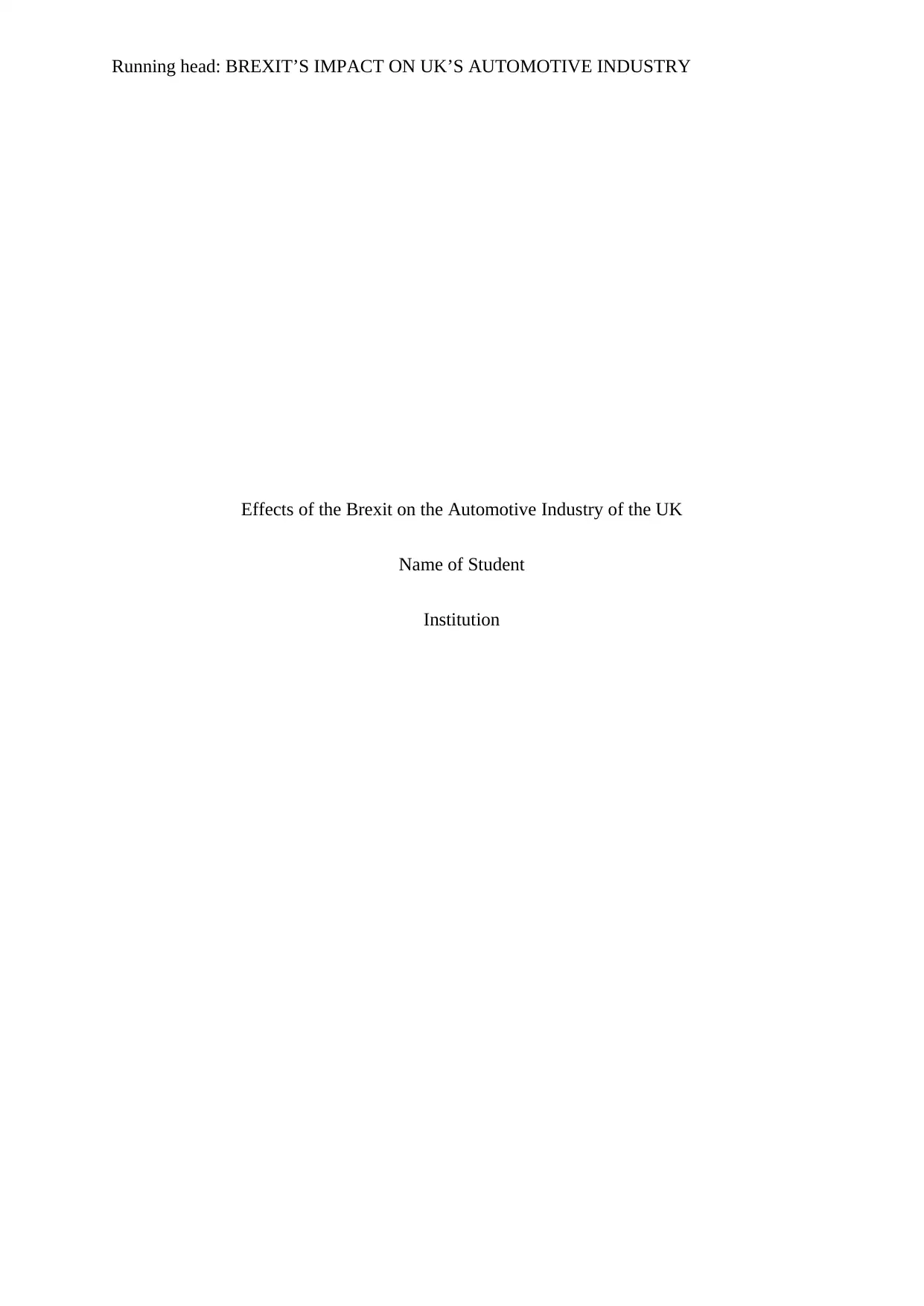
Running head: BREXIT’S IMPACT ON UK’S AUTOMOTIVE INDUSTRY
Effects of the Brexit on the Automotive Industry of the UK
Name of Student
Institution
Effects of the Brexit on the Automotive Industry of the UK
Name of Student
Institution
Paraphrase This Document
Need a fresh take? Get an instant paraphrase of this document with our AI Paraphraser

BREXIT’S IMPACT ON UK’S AUTOMOTIVE INDUSTRY 2
Effects of Brexit on the Automotive Industry of the UK
Effects of Brexit on the Automotive Industry of the UK
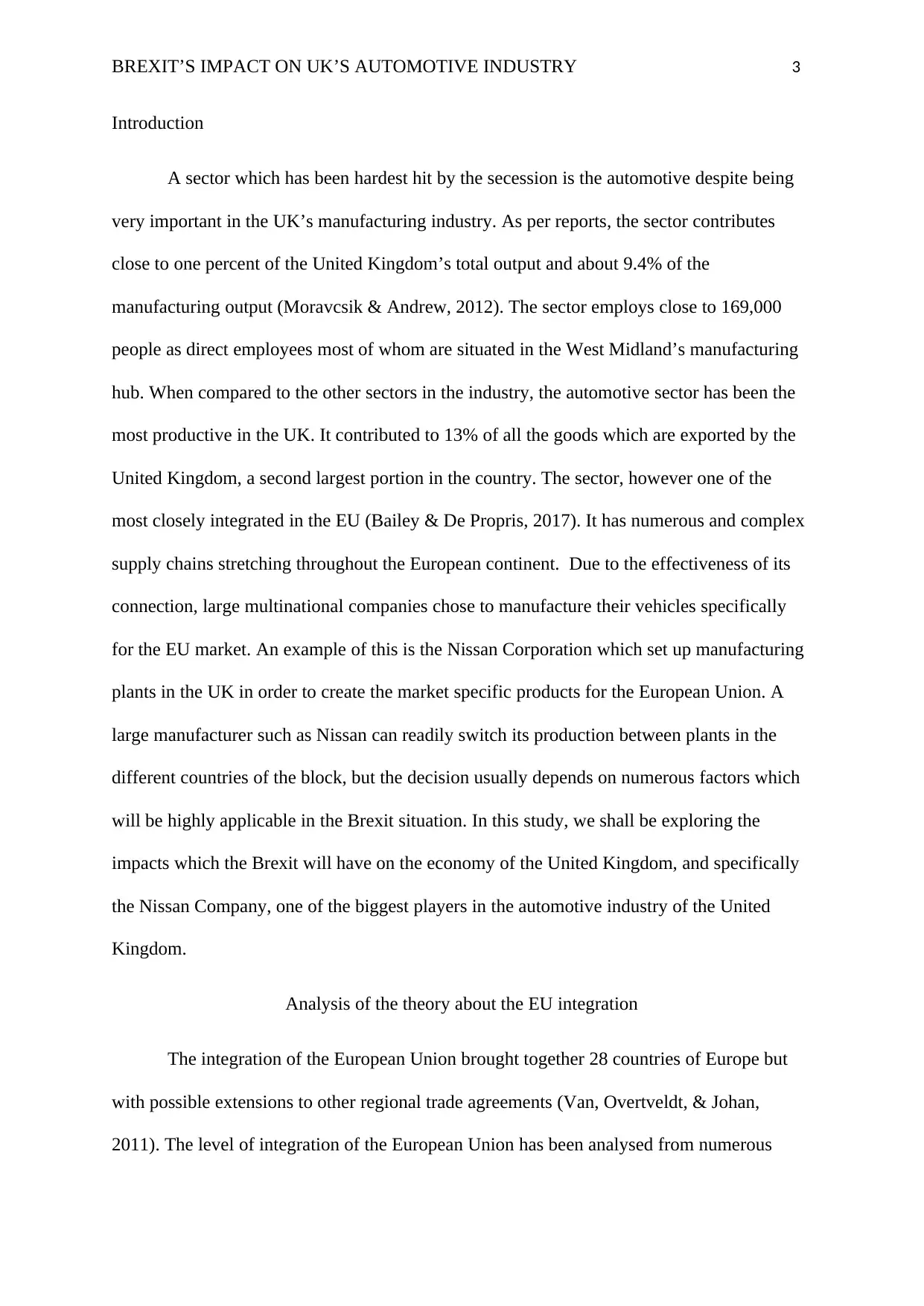
BREXIT’S IMPACT ON UK’S AUTOMOTIVE INDUSTRY 3
Introduction
A sector which has been hardest hit by the secession is the automotive despite being
very important in the UK’s manufacturing industry. As per reports, the sector contributes
close to one percent of the United Kingdom’s total output and about 9.4% of the
manufacturing output (Moravcsik & Andrew, 2012). The sector employs close to 169,000
people as direct employees most of whom are situated in the West Midland’s manufacturing
hub. When compared to the other sectors in the industry, the automotive sector has been the
most productive in the UK. It contributed to 13% of all the goods which are exported by the
United Kingdom, a second largest portion in the country. The sector, however one of the
most closely integrated in the EU (Bailey & De Propris, 2017). It has numerous and complex
supply chains stretching throughout the European continent. Due to the effectiveness of its
connection, large multinational companies chose to manufacture their vehicles specifically
for the EU market. An example of this is the Nissan Corporation which set up manufacturing
plants in the UK in order to create the market specific products for the European Union. A
large manufacturer such as Nissan can readily switch its production between plants in the
different countries of the block, but the decision usually depends on numerous factors which
will be highly applicable in the Brexit situation. In this study, we shall be exploring the
impacts which the Brexit will have on the economy of the United Kingdom, and specifically
the Nissan Company, one of the biggest players in the automotive industry of the United
Kingdom.
Analysis of the theory about the EU integration
The integration of the European Union brought together 28 countries of Europe but
with possible extensions to other regional trade agreements (Van, Overtveldt, & Johan,
2011). The level of integration of the European Union has been analysed from numerous
Introduction
A sector which has been hardest hit by the secession is the automotive despite being
very important in the UK’s manufacturing industry. As per reports, the sector contributes
close to one percent of the United Kingdom’s total output and about 9.4% of the
manufacturing output (Moravcsik & Andrew, 2012). The sector employs close to 169,000
people as direct employees most of whom are situated in the West Midland’s manufacturing
hub. When compared to the other sectors in the industry, the automotive sector has been the
most productive in the UK. It contributed to 13% of all the goods which are exported by the
United Kingdom, a second largest portion in the country. The sector, however one of the
most closely integrated in the EU (Bailey & De Propris, 2017). It has numerous and complex
supply chains stretching throughout the European continent. Due to the effectiveness of its
connection, large multinational companies chose to manufacture their vehicles specifically
for the EU market. An example of this is the Nissan Corporation which set up manufacturing
plants in the UK in order to create the market specific products for the European Union. A
large manufacturer such as Nissan can readily switch its production between plants in the
different countries of the block, but the decision usually depends on numerous factors which
will be highly applicable in the Brexit situation. In this study, we shall be exploring the
impacts which the Brexit will have on the economy of the United Kingdom, and specifically
the Nissan Company, one of the biggest players in the automotive industry of the United
Kingdom.
Analysis of the theory about the EU integration
The integration of the European Union brought together 28 countries of Europe but
with possible extensions to other regional trade agreements (Van, Overtveldt, & Johan,
2011). The level of integration of the European Union has been analysed from numerous
⊘ This is a preview!⊘
Do you want full access?
Subscribe today to unlock all pages.

Trusted by 1+ million students worldwide
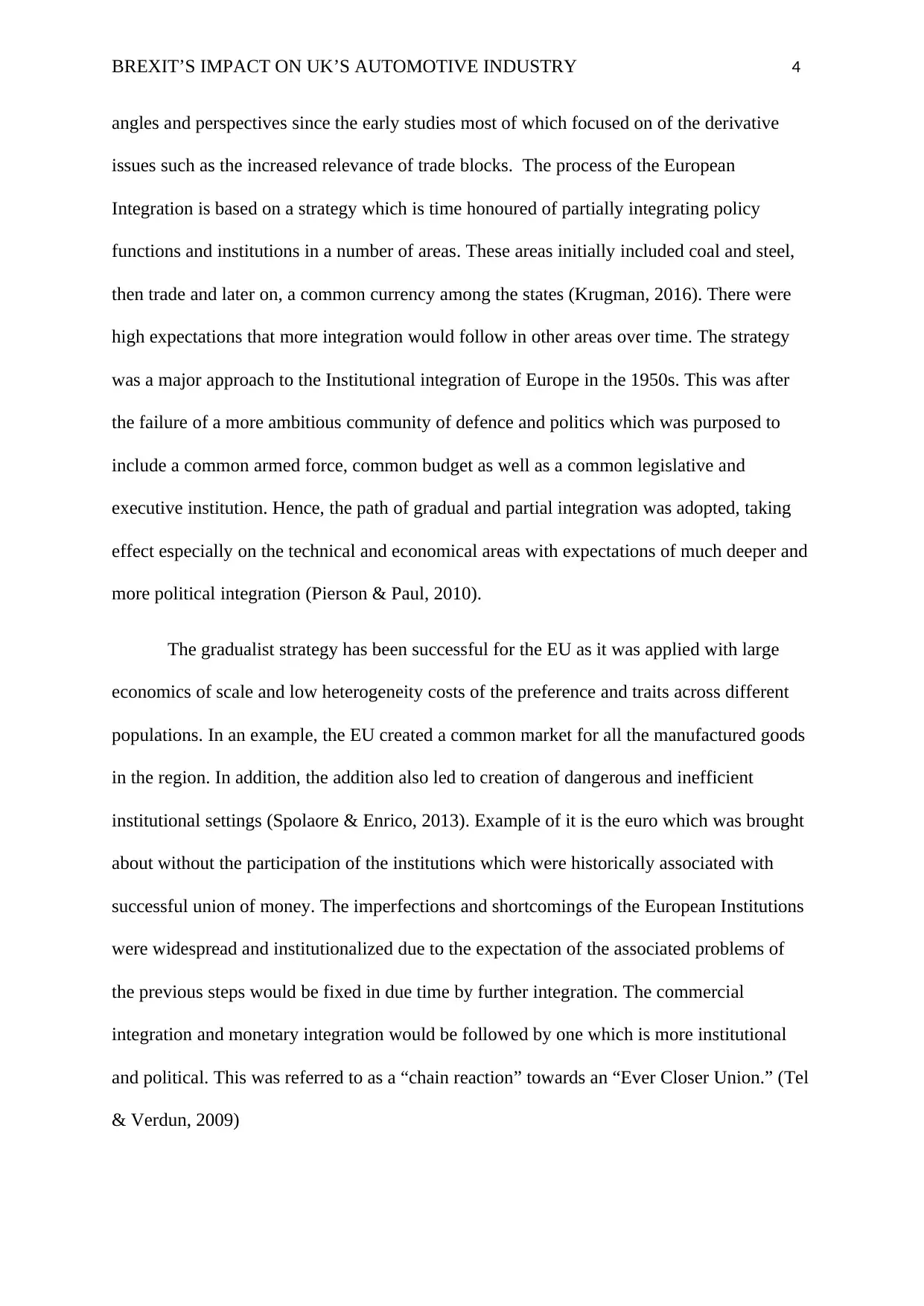
BREXIT’S IMPACT ON UK’S AUTOMOTIVE INDUSTRY 4
angles and perspectives since the early studies most of which focused on of the derivative
issues such as the increased relevance of trade blocks. The process of the European
Integration is based on a strategy which is time honoured of partially integrating policy
functions and institutions in a number of areas. These areas initially included coal and steel,
then trade and later on, a common currency among the states (Krugman, 2016). There were
high expectations that more integration would follow in other areas over time. The strategy
was a major approach to the Institutional integration of Europe in the 1950s. This was after
the failure of a more ambitious community of defence and politics which was purposed to
include a common armed force, common budget as well as a common legislative and
executive institution. Hence, the path of gradual and partial integration was adopted, taking
effect especially on the technical and economical areas with expectations of much deeper and
more political integration (Pierson & Paul, 2010).
The gradualist strategy has been successful for the EU as it was applied with large
economics of scale and low heterogeneity costs of the preference and traits across different
populations. In an example, the EU created a common market for all the manufactured goods
in the region. In addition, the addition also led to creation of dangerous and inefficient
institutional settings (Spolaore & Enrico, 2013). Example of it is the euro which was brought
about without the participation of the institutions which were historically associated with
successful union of money. The imperfections and shortcomings of the European Institutions
were widespread and institutionalized due to the expectation of the associated problems of
the previous steps would be fixed in due time by further integration. The commercial
integration and monetary integration would be followed by one which is more institutional
and political. This was referred to as a “chain reaction” towards an “Ever Closer Union.” (Tel
& Verdun, 2009)
angles and perspectives since the early studies most of which focused on of the derivative
issues such as the increased relevance of trade blocks. The process of the European
Integration is based on a strategy which is time honoured of partially integrating policy
functions and institutions in a number of areas. These areas initially included coal and steel,
then trade and later on, a common currency among the states (Krugman, 2016). There were
high expectations that more integration would follow in other areas over time. The strategy
was a major approach to the Institutional integration of Europe in the 1950s. This was after
the failure of a more ambitious community of defence and politics which was purposed to
include a common armed force, common budget as well as a common legislative and
executive institution. Hence, the path of gradual and partial integration was adopted, taking
effect especially on the technical and economical areas with expectations of much deeper and
more political integration (Pierson & Paul, 2010).
The gradualist strategy has been successful for the EU as it was applied with large
economics of scale and low heterogeneity costs of the preference and traits across different
populations. In an example, the EU created a common market for all the manufactured goods
in the region. In addition, the addition also led to creation of dangerous and inefficient
institutional settings (Spolaore & Enrico, 2013). Example of it is the euro which was brought
about without the participation of the institutions which were historically associated with
successful union of money. The imperfections and shortcomings of the European Institutions
were widespread and institutionalized due to the expectation of the associated problems of
the previous steps would be fixed in due time by further integration. The commercial
integration and monetary integration would be followed by one which is more institutional
and political. This was referred to as a “chain reaction” towards an “Ever Closer Union.” (Tel
& Verdun, 2009)
Paraphrase This Document
Need a fresh take? Get an instant paraphrase of this document with our AI Paraphraser
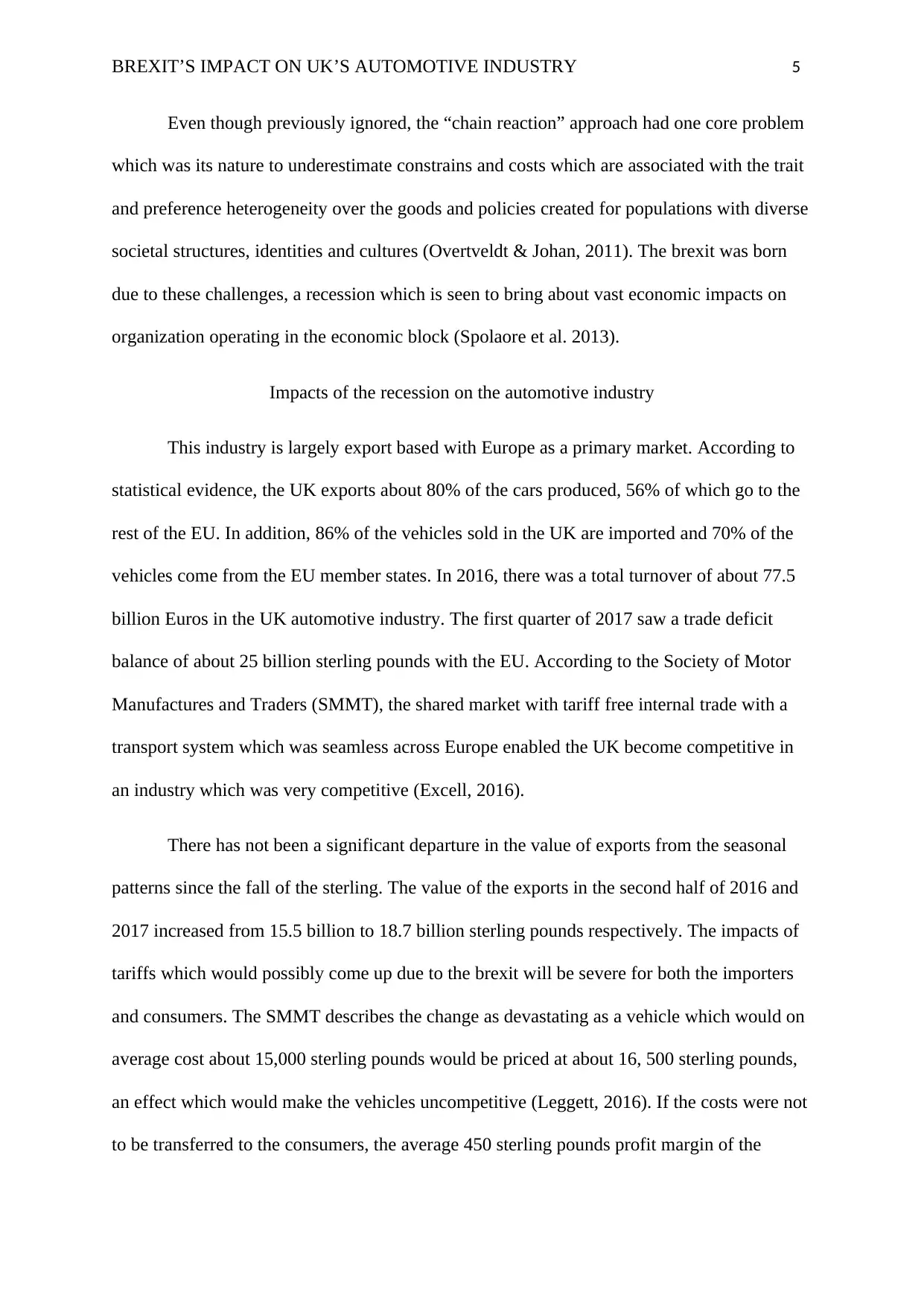
BREXIT’S IMPACT ON UK’S AUTOMOTIVE INDUSTRY 5
Even though previously ignored, the “chain reaction” approach had one core problem
which was its nature to underestimate constrains and costs which are associated with the trait
and preference heterogeneity over the goods and policies created for populations with diverse
societal structures, identities and cultures (Overtveldt & Johan, 2011). The brexit was born
due to these challenges, a recession which is seen to bring about vast economic impacts on
organization operating in the economic block (Spolaore et al. 2013).
Impacts of the recession on the automotive industry
This industry is largely export based with Europe as a primary market. According to
statistical evidence, the UK exports about 80% of the cars produced, 56% of which go to the
rest of the EU. In addition, 86% of the vehicles sold in the UK are imported and 70% of the
vehicles come from the EU member states. In 2016, there was a total turnover of about 77.5
billion Euros in the UK automotive industry. The first quarter of 2017 saw a trade deficit
balance of about 25 billion sterling pounds with the EU. According to the Society of Motor
Manufactures and Traders (SMMT), the shared market with tariff free internal trade with a
transport system which was seamless across Europe enabled the UK become competitive in
an industry which was very competitive (Excell, 2016).
There has not been a significant departure in the value of exports from the seasonal
patterns since the fall of the sterling. The value of the exports in the second half of 2016 and
2017 increased from 15.5 billion to 18.7 billion sterling pounds respectively. The impacts of
tariffs which would possibly come up due to the brexit will be severe for both the importers
and consumers. The SMMT describes the change as devastating as a vehicle which would on
average cost about 15,000 sterling pounds would be priced at about 16, 500 sterling pounds,
an effect which would make the vehicles uncompetitive (Leggett, 2016). If the costs were not
to be transferred to the consumers, the average 450 sterling pounds profit margin of the
Even though previously ignored, the “chain reaction” approach had one core problem
which was its nature to underestimate constrains and costs which are associated with the trait
and preference heterogeneity over the goods and policies created for populations with diverse
societal structures, identities and cultures (Overtveldt & Johan, 2011). The brexit was born
due to these challenges, a recession which is seen to bring about vast economic impacts on
organization operating in the economic block (Spolaore et al. 2013).
Impacts of the recession on the automotive industry
This industry is largely export based with Europe as a primary market. According to
statistical evidence, the UK exports about 80% of the cars produced, 56% of which go to the
rest of the EU. In addition, 86% of the vehicles sold in the UK are imported and 70% of the
vehicles come from the EU member states. In 2016, there was a total turnover of about 77.5
billion Euros in the UK automotive industry. The first quarter of 2017 saw a trade deficit
balance of about 25 billion sterling pounds with the EU. According to the Society of Motor
Manufactures and Traders (SMMT), the shared market with tariff free internal trade with a
transport system which was seamless across Europe enabled the UK become competitive in
an industry which was very competitive (Excell, 2016).
There has not been a significant departure in the value of exports from the seasonal
patterns since the fall of the sterling. The value of the exports in the second half of 2016 and
2017 increased from 15.5 billion to 18.7 billion sterling pounds respectively. The impacts of
tariffs which would possibly come up due to the brexit will be severe for both the importers
and consumers. The SMMT describes the change as devastating as a vehicle which would on
average cost about 15,000 sterling pounds would be priced at about 16, 500 sterling pounds,
an effect which would make the vehicles uncompetitive (Leggett, 2016). If the costs were not
to be transferred to the consumers, the average 450 sterling pounds profit margin of the
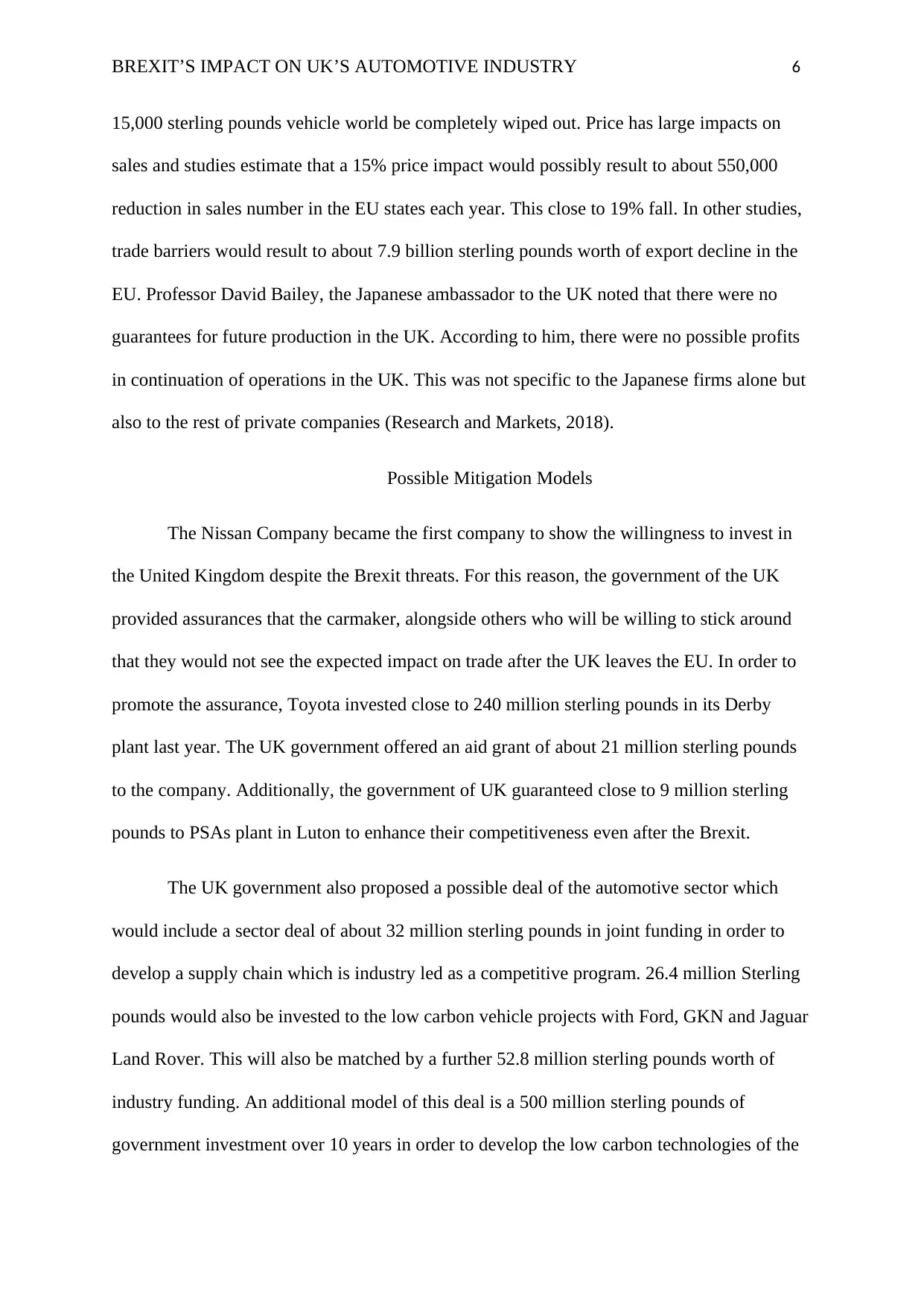
BREXIT’S IMPACT ON UK’S AUTOMOTIVE INDUSTRY 6
15,000 sterling pounds vehicle world be completely wiped out. Price has large impacts on
sales and studies estimate that a 15% price impact would possibly result to about 550,000
reduction in sales number in the EU states each year. This close to 19% fall. In other studies,
trade barriers would result to about 7.9 billion sterling pounds worth of export decline in the
EU. Professor David Bailey, the Japanese ambassador to the UK noted that there were no
guarantees for future production in the UK. According to him, there were no possible profits
in continuation of operations in the UK. This was not specific to the Japanese firms alone but
also to the rest of private companies (Research and Markets, 2018).
Possible Mitigation Models
The Nissan Company became the first company to show the willingness to invest in
the United Kingdom despite the Brexit threats. For this reason, the government of the UK
provided assurances that the carmaker, alongside others who will be willing to stick around
that they would not see the expected impact on trade after the UK leaves the EU. In order to
promote the assurance, Toyota invested close to 240 million sterling pounds in its Derby
plant last year. The UK government offered an aid grant of about 21 million sterling pounds
to the company. Additionally, the government of UK guaranteed close to 9 million sterling
pounds to PSAs plant in Luton to enhance their competitiveness even after the Brexit.
The UK government also proposed a possible deal of the automotive sector which
would include a sector deal of about 32 million sterling pounds in joint funding in order to
develop a supply chain which is industry led as a competitive program. 26.4 million Sterling
pounds would also be invested to the low carbon vehicle projects with Ford, GKN and Jaguar
Land Rover. This will also be matched by a further 52.8 million sterling pounds worth of
industry funding. An additional model of this deal is a 500 million sterling pounds of
government investment over 10 years in order to develop the low carbon technologies of the
15,000 sterling pounds vehicle world be completely wiped out. Price has large impacts on
sales and studies estimate that a 15% price impact would possibly result to about 550,000
reduction in sales number in the EU states each year. This close to 19% fall. In other studies,
trade barriers would result to about 7.9 billion sterling pounds worth of export decline in the
EU. Professor David Bailey, the Japanese ambassador to the UK noted that there were no
guarantees for future production in the UK. According to him, there were no possible profits
in continuation of operations in the UK. This was not specific to the Japanese firms alone but
also to the rest of private companies (Research and Markets, 2018).
Possible Mitigation Models
The Nissan Company became the first company to show the willingness to invest in
the United Kingdom despite the Brexit threats. For this reason, the government of the UK
provided assurances that the carmaker, alongside others who will be willing to stick around
that they would not see the expected impact on trade after the UK leaves the EU. In order to
promote the assurance, Toyota invested close to 240 million sterling pounds in its Derby
plant last year. The UK government offered an aid grant of about 21 million sterling pounds
to the company. Additionally, the government of UK guaranteed close to 9 million sterling
pounds to PSAs plant in Luton to enhance their competitiveness even after the Brexit.
The UK government also proposed a possible deal of the automotive sector which
would include a sector deal of about 32 million sterling pounds in joint funding in order to
develop a supply chain which is industry led as a competitive program. 26.4 million Sterling
pounds would also be invested to the low carbon vehicle projects with Ford, GKN and Jaguar
Land Rover. This will also be matched by a further 52.8 million sterling pounds worth of
industry funding. An additional model of this deal is a 500 million sterling pounds of
government investment over 10 years in order to develop the low carbon technologies of the
⊘ This is a preview!⊘
Do you want full access?
Subscribe today to unlock all pages.

Trusted by 1+ million students worldwide
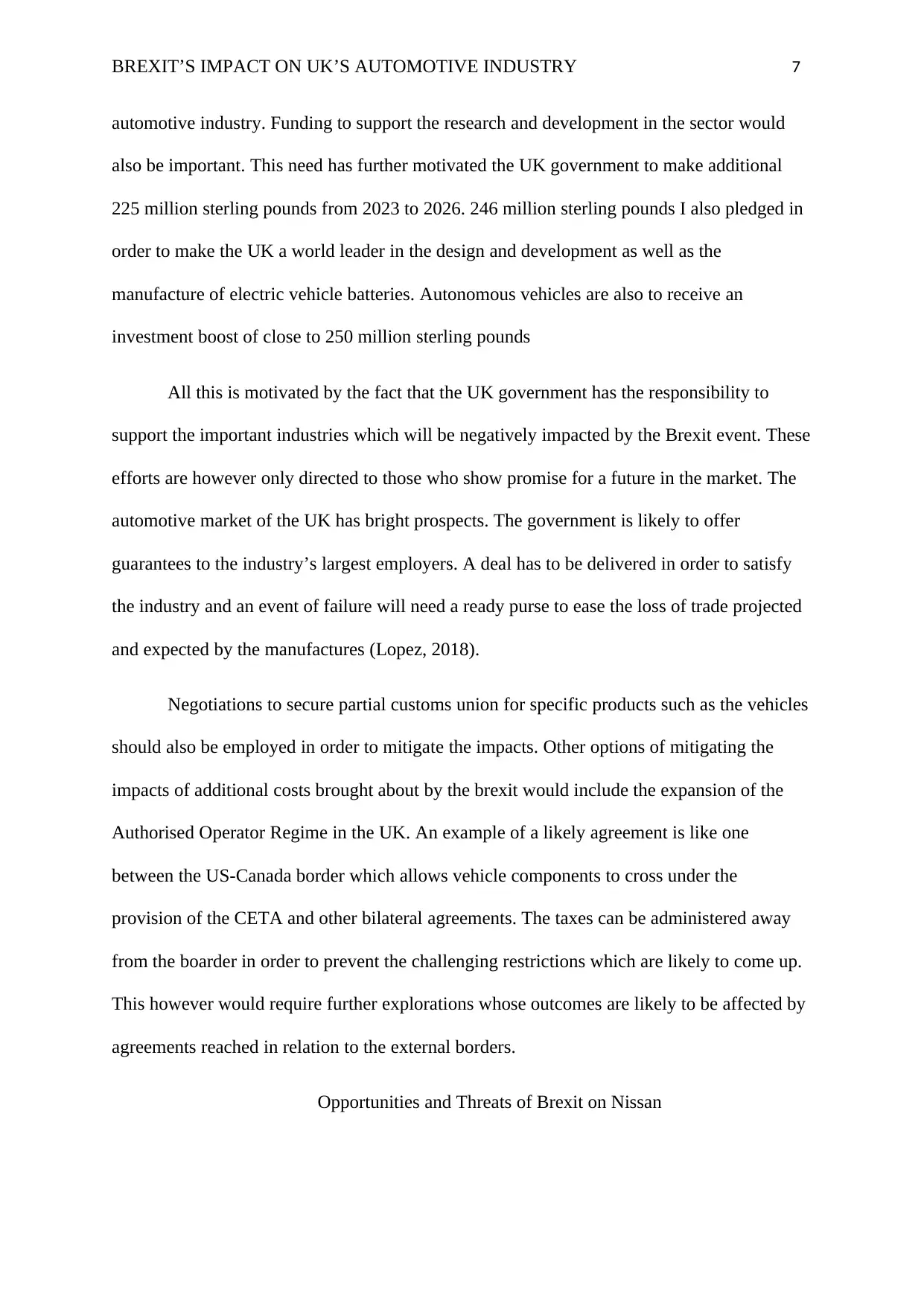
BREXIT’S IMPACT ON UK’S AUTOMOTIVE INDUSTRY 7
automotive industry. Funding to support the research and development in the sector would
also be important. This need has further motivated the UK government to make additional
225 million sterling pounds from 2023 to 2026. 246 million sterling pounds I also pledged in
order to make the UK a world leader in the design and development as well as the
manufacture of electric vehicle batteries. Autonomous vehicles are also to receive an
investment boost of close to 250 million sterling pounds
All this is motivated by the fact that the UK government has the responsibility to
support the important industries which will be negatively impacted by the Brexit event. These
efforts are however only directed to those who show promise for a future in the market. The
automotive market of the UK has bright prospects. The government is likely to offer
guarantees to the industry’s largest employers. A deal has to be delivered in order to satisfy
the industry and an event of failure will need a ready purse to ease the loss of trade projected
and expected by the manufactures (Lopez, 2018).
Negotiations to secure partial customs union for specific products such as the vehicles
should also be employed in order to mitigate the impacts. Other options of mitigating the
impacts of additional costs brought about by the brexit would include the expansion of the
Authorised Operator Regime in the UK. An example of a likely agreement is like one
between the US-Canada border which allows vehicle components to cross under the
provision of the CETA and other bilateral agreements. The taxes can be administered away
from the boarder in order to prevent the challenging restrictions which are likely to come up.
This however would require further explorations whose outcomes are likely to be affected by
agreements reached in relation to the external borders.
Opportunities and Threats of Brexit on Nissan
automotive industry. Funding to support the research and development in the sector would
also be important. This need has further motivated the UK government to make additional
225 million sterling pounds from 2023 to 2026. 246 million sterling pounds I also pledged in
order to make the UK a world leader in the design and development as well as the
manufacture of electric vehicle batteries. Autonomous vehicles are also to receive an
investment boost of close to 250 million sterling pounds
All this is motivated by the fact that the UK government has the responsibility to
support the important industries which will be negatively impacted by the Brexit event. These
efforts are however only directed to those who show promise for a future in the market. The
automotive market of the UK has bright prospects. The government is likely to offer
guarantees to the industry’s largest employers. A deal has to be delivered in order to satisfy
the industry and an event of failure will need a ready purse to ease the loss of trade projected
and expected by the manufactures (Lopez, 2018).
Negotiations to secure partial customs union for specific products such as the vehicles
should also be employed in order to mitigate the impacts. Other options of mitigating the
impacts of additional costs brought about by the brexit would include the expansion of the
Authorised Operator Regime in the UK. An example of a likely agreement is like one
between the US-Canada border which allows vehicle components to cross under the
provision of the CETA and other bilateral agreements. The taxes can be administered away
from the boarder in order to prevent the challenging restrictions which are likely to come up.
This however would require further explorations whose outcomes are likely to be affected by
agreements reached in relation to the external borders.
Opportunities and Threats of Brexit on Nissan
Paraphrase This Document
Need a fresh take? Get an instant paraphrase of this document with our AI Paraphraser
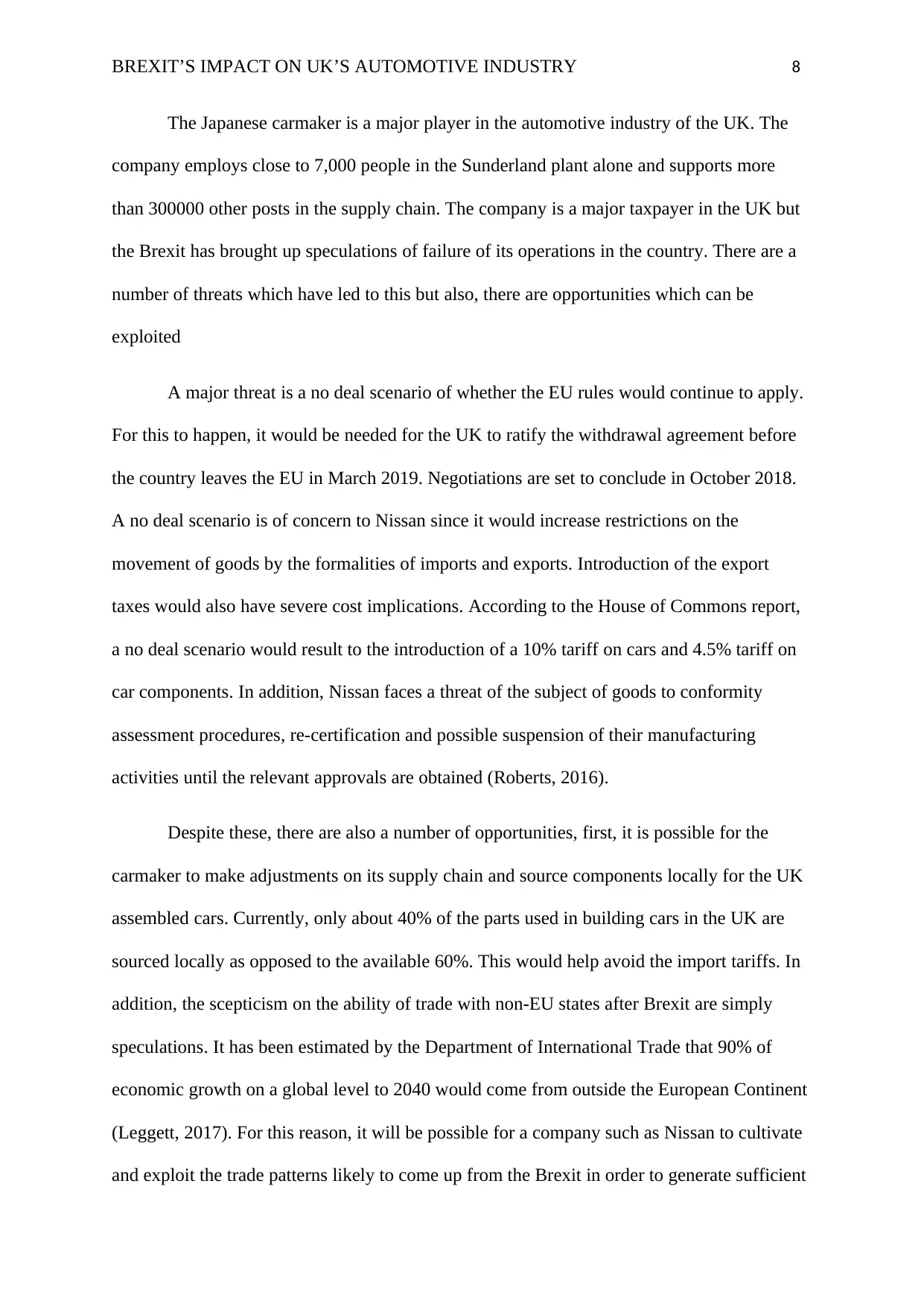
BREXIT’S IMPACT ON UK’S AUTOMOTIVE INDUSTRY 8
The Japanese carmaker is a major player in the automotive industry of the UK. The
company employs close to 7,000 people in the Sunderland plant alone and supports more
than 300000 other posts in the supply chain. The company is a major taxpayer in the UK but
the Brexit has brought up speculations of failure of its operations in the country. There are a
number of threats which have led to this but also, there are opportunities which can be
exploited
A major threat is a no deal scenario of whether the EU rules would continue to apply.
For this to happen, it would be needed for the UK to ratify the withdrawal agreement before
the country leaves the EU in March 2019. Negotiations are set to conclude in October 2018.
A no deal scenario is of concern to Nissan since it would increase restrictions on the
movement of goods by the formalities of imports and exports. Introduction of the export
taxes would also have severe cost implications. According to the House of Commons report,
a no deal scenario would result to the introduction of a 10% tariff on cars and 4.5% tariff on
car components. In addition, Nissan faces a threat of the subject of goods to conformity
assessment procedures, re-certification and possible suspension of their manufacturing
activities until the relevant approvals are obtained (Roberts, 2016).
Despite these, there are also a number of opportunities, first, it is possible for the
carmaker to make adjustments on its supply chain and source components locally for the UK
assembled cars. Currently, only about 40% of the parts used in building cars in the UK are
sourced locally as opposed to the available 60%. This would help avoid the import tariffs. In
addition, the scepticism on the ability of trade with non-EU states after Brexit are simply
speculations. It has been estimated by the Department of International Trade that 90% of
economic growth on a global level to 2040 would come from outside the European Continent
(Leggett, 2017). For this reason, it will be possible for a company such as Nissan to cultivate
and exploit the trade patterns likely to come up from the Brexit in order to generate sufficient
The Japanese carmaker is a major player in the automotive industry of the UK. The
company employs close to 7,000 people in the Sunderland plant alone and supports more
than 300000 other posts in the supply chain. The company is a major taxpayer in the UK but
the Brexit has brought up speculations of failure of its operations in the country. There are a
number of threats which have led to this but also, there are opportunities which can be
exploited
A major threat is a no deal scenario of whether the EU rules would continue to apply.
For this to happen, it would be needed for the UK to ratify the withdrawal agreement before
the country leaves the EU in March 2019. Negotiations are set to conclude in October 2018.
A no deal scenario is of concern to Nissan since it would increase restrictions on the
movement of goods by the formalities of imports and exports. Introduction of the export
taxes would also have severe cost implications. According to the House of Commons report,
a no deal scenario would result to the introduction of a 10% tariff on cars and 4.5% tariff on
car components. In addition, Nissan faces a threat of the subject of goods to conformity
assessment procedures, re-certification and possible suspension of their manufacturing
activities until the relevant approvals are obtained (Roberts, 2016).
Despite these, there are also a number of opportunities, first, it is possible for the
carmaker to make adjustments on its supply chain and source components locally for the UK
assembled cars. Currently, only about 40% of the parts used in building cars in the UK are
sourced locally as opposed to the available 60%. This would help avoid the import tariffs. In
addition, the scepticism on the ability of trade with non-EU states after Brexit are simply
speculations. It has been estimated by the Department of International Trade that 90% of
economic growth on a global level to 2040 would come from outside the European Continent
(Leggett, 2017). For this reason, it will be possible for a company such as Nissan to cultivate
and exploit the trade patterns likely to come up from the Brexit in order to generate sufficient
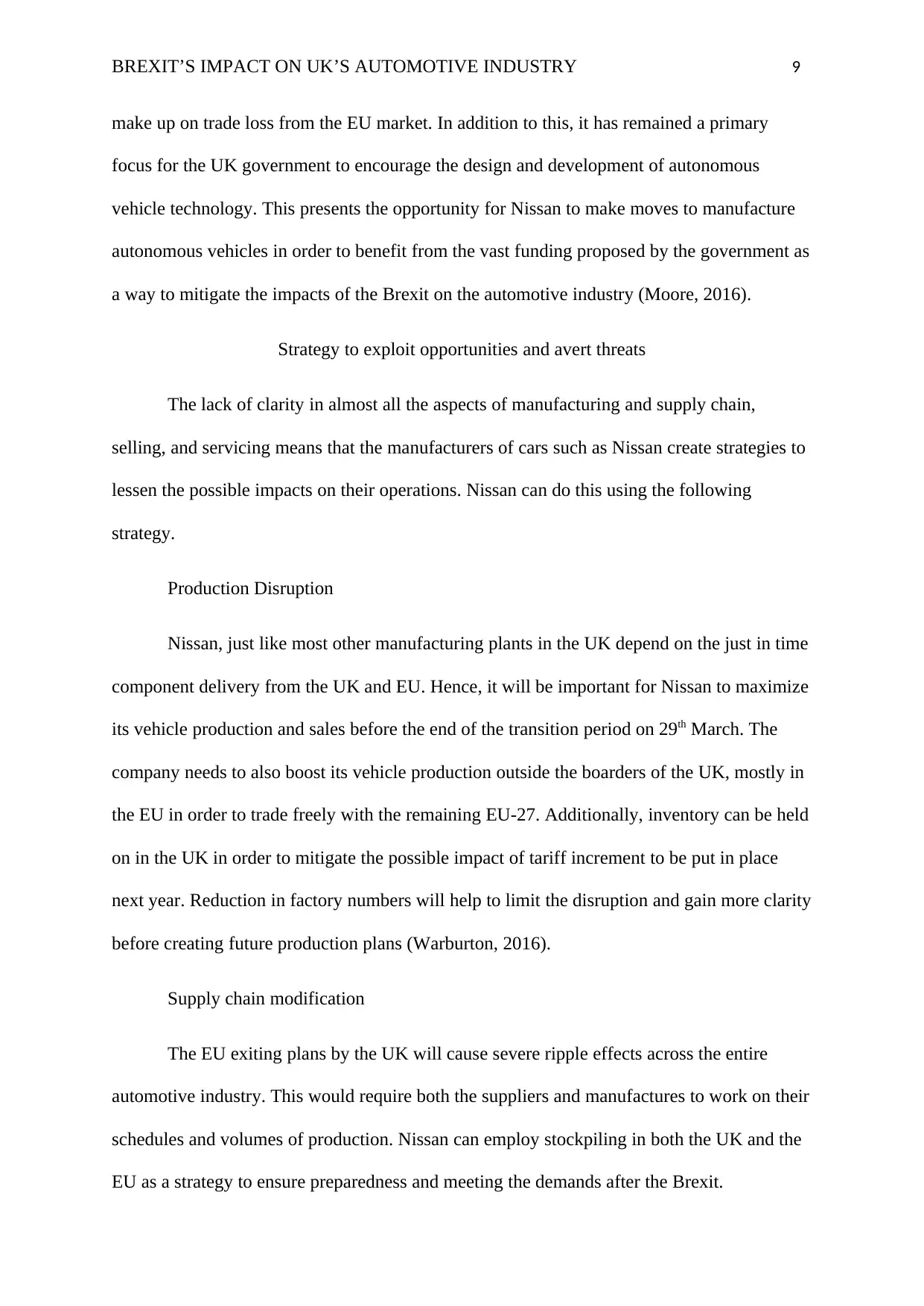
BREXIT’S IMPACT ON UK’S AUTOMOTIVE INDUSTRY 9
make up on trade loss from the EU market. In addition to this, it has remained a primary
focus for the UK government to encourage the design and development of autonomous
vehicle technology. This presents the opportunity for Nissan to make moves to manufacture
autonomous vehicles in order to benefit from the vast funding proposed by the government as
a way to mitigate the impacts of the Brexit on the automotive industry (Moore, 2016).
Strategy to exploit opportunities and avert threats
The lack of clarity in almost all the aspects of manufacturing and supply chain,
selling, and servicing means that the manufacturers of cars such as Nissan create strategies to
lessen the possible impacts on their operations. Nissan can do this using the following
strategy.
Production Disruption
Nissan, just like most other manufacturing plants in the UK depend on the just in time
component delivery from the UK and EU. Hence, it will be important for Nissan to maximize
its vehicle production and sales before the end of the transition period on 29th March. The
company needs to also boost its vehicle production outside the boarders of the UK, mostly in
the EU in order to trade freely with the remaining EU-27. Additionally, inventory can be held
on in the UK in order to mitigate the possible impact of tariff increment to be put in place
next year. Reduction in factory numbers will help to limit the disruption and gain more clarity
before creating future production plans (Warburton, 2016).
Supply chain modification
The EU exiting plans by the UK will cause severe ripple effects across the entire
automotive industry. This would require both the suppliers and manufactures to work on their
schedules and volumes of production. Nissan can employ stockpiling in both the UK and the
EU as a strategy to ensure preparedness and meeting the demands after the Brexit.
make up on trade loss from the EU market. In addition to this, it has remained a primary
focus for the UK government to encourage the design and development of autonomous
vehicle technology. This presents the opportunity for Nissan to make moves to manufacture
autonomous vehicles in order to benefit from the vast funding proposed by the government as
a way to mitigate the impacts of the Brexit on the automotive industry (Moore, 2016).
Strategy to exploit opportunities and avert threats
The lack of clarity in almost all the aspects of manufacturing and supply chain,
selling, and servicing means that the manufacturers of cars such as Nissan create strategies to
lessen the possible impacts on their operations. Nissan can do this using the following
strategy.
Production Disruption
Nissan, just like most other manufacturing plants in the UK depend on the just in time
component delivery from the UK and EU. Hence, it will be important for Nissan to maximize
its vehicle production and sales before the end of the transition period on 29th March. The
company needs to also boost its vehicle production outside the boarders of the UK, mostly in
the EU in order to trade freely with the remaining EU-27. Additionally, inventory can be held
on in the UK in order to mitigate the possible impact of tariff increment to be put in place
next year. Reduction in factory numbers will help to limit the disruption and gain more clarity
before creating future production plans (Warburton, 2016).
Supply chain modification
The EU exiting plans by the UK will cause severe ripple effects across the entire
automotive industry. This would require both the suppliers and manufactures to work on their
schedules and volumes of production. Nissan can employ stockpiling in both the UK and the
EU as a strategy to ensure preparedness and meeting the demands after the Brexit.
⊘ This is a preview!⊘
Do you want full access?
Subscribe today to unlock all pages.

Trusted by 1+ million students worldwide
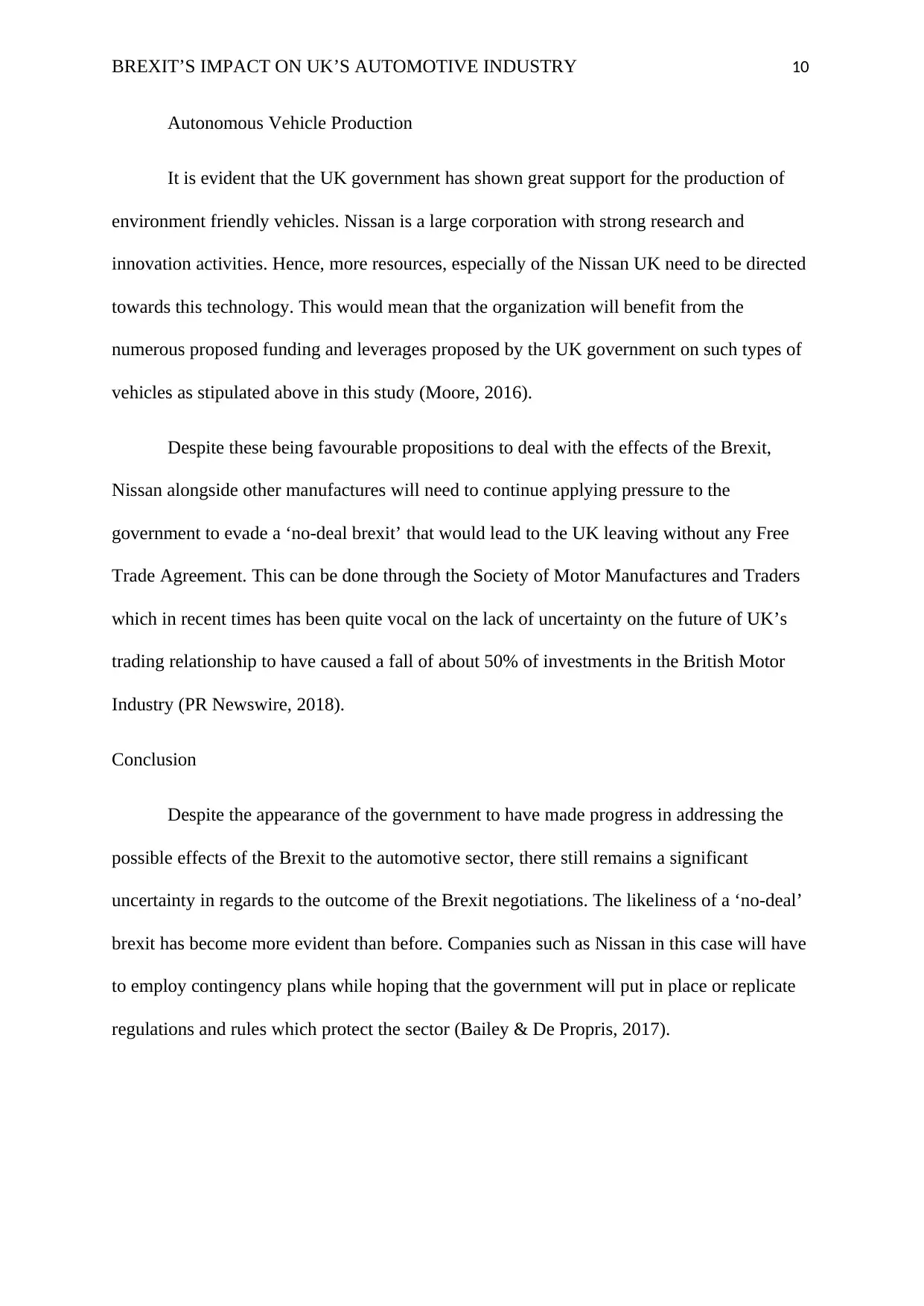
BREXIT’S IMPACT ON UK’S AUTOMOTIVE INDUSTRY 10
Autonomous Vehicle Production
It is evident that the UK government has shown great support for the production of
environment friendly vehicles. Nissan is a large corporation with strong research and
innovation activities. Hence, more resources, especially of the Nissan UK need to be directed
towards this technology. This would mean that the organization will benefit from the
numerous proposed funding and leverages proposed by the UK government on such types of
vehicles as stipulated above in this study (Moore, 2016).
Despite these being favourable propositions to deal with the effects of the Brexit,
Nissan alongside other manufactures will need to continue applying pressure to the
government to evade a ‘no-deal brexit’ that would lead to the UK leaving without any Free
Trade Agreement. This can be done through the Society of Motor Manufactures and Traders
which in recent times has been quite vocal on the lack of uncertainty on the future of UK’s
trading relationship to have caused a fall of about 50% of investments in the British Motor
Industry (PR Newswire, 2018).
Conclusion
Despite the appearance of the government to have made progress in addressing the
possible effects of the Brexit to the automotive sector, there still remains a significant
uncertainty in regards to the outcome of the Brexit negotiations. The likeliness of a ‘no-deal’
brexit has become more evident than before. Companies such as Nissan in this case will have
to employ contingency plans while hoping that the government will put in place or replicate
regulations and rules which protect the sector (Bailey & De Propris, 2017).
Autonomous Vehicle Production
It is evident that the UK government has shown great support for the production of
environment friendly vehicles. Nissan is a large corporation with strong research and
innovation activities. Hence, more resources, especially of the Nissan UK need to be directed
towards this technology. This would mean that the organization will benefit from the
numerous proposed funding and leverages proposed by the UK government on such types of
vehicles as stipulated above in this study (Moore, 2016).
Despite these being favourable propositions to deal with the effects of the Brexit,
Nissan alongside other manufactures will need to continue applying pressure to the
government to evade a ‘no-deal brexit’ that would lead to the UK leaving without any Free
Trade Agreement. This can be done through the Society of Motor Manufactures and Traders
which in recent times has been quite vocal on the lack of uncertainty on the future of UK’s
trading relationship to have caused a fall of about 50% of investments in the British Motor
Industry (PR Newswire, 2018).
Conclusion
Despite the appearance of the government to have made progress in addressing the
possible effects of the Brexit to the automotive sector, there still remains a significant
uncertainty in regards to the outcome of the Brexit negotiations. The likeliness of a ‘no-deal’
brexit has become more evident than before. Companies such as Nissan in this case will have
to employ contingency plans while hoping that the government will put in place or replicate
regulations and rules which protect the sector (Bailey & De Propris, 2017).
Paraphrase This Document
Need a fresh take? Get an instant paraphrase of this document with our AI Paraphraser
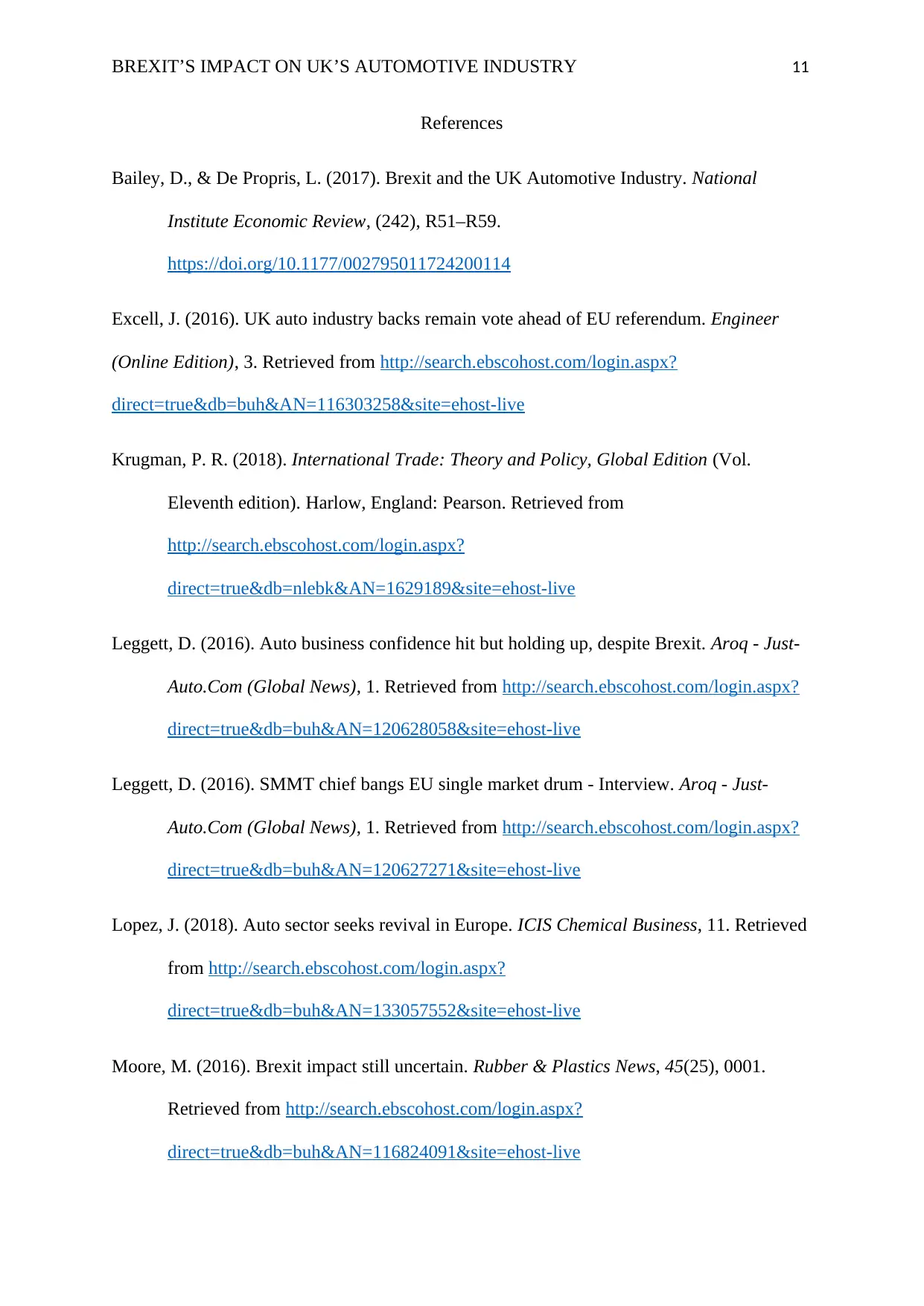
BREXIT’S IMPACT ON UK’S AUTOMOTIVE INDUSTRY 11
References
Bailey, D., & De Propris, L. (2017). Brexit and the UK Automotive Industry. National
Institute Economic Review, (242), R51–R59.
https://doi.org/10.1177/002795011724200114
Excell, J. (2016). UK auto industry backs remain vote ahead of EU referendum. Engineer
(Online Edition), 3. Retrieved from http://search.ebscohost.com/login.aspx?
direct=true&db=buh&AN=116303258&site=ehost-live
Krugman, P. R. (2018). International Trade: Theory and Policy, Global Edition (Vol.
Eleventh edition). Harlow, England: Pearson. Retrieved from
http://search.ebscohost.com/login.aspx?
direct=true&db=nlebk&AN=1629189&site=ehost-live
Leggett, D. (2016). Auto business confidence hit but holding up, despite Brexit. Aroq - Just-
Auto.Com (Global News), 1. Retrieved from http://search.ebscohost.com/login.aspx?
direct=true&db=buh&AN=120628058&site=ehost-live
Leggett, D. (2016). SMMT chief bangs EU single market drum - Interview. Aroq - Just-
Auto.Com (Global News), 1. Retrieved from http://search.ebscohost.com/login.aspx?
direct=true&db=buh&AN=120627271&site=ehost-live
Lopez, J. (2018). Auto sector seeks revival in Europe. ICIS Chemical Business, 11. Retrieved
from http://search.ebscohost.com/login.aspx?
direct=true&db=buh&AN=133057552&site=ehost-live
Moore, M. (2016). Brexit impact still uncertain. Rubber & Plastics News, 45(25), 0001.
Retrieved from http://search.ebscohost.com/login.aspx?
direct=true&db=buh&AN=116824091&site=ehost-live
References
Bailey, D., & De Propris, L. (2017). Brexit and the UK Automotive Industry. National
Institute Economic Review, (242), R51–R59.
https://doi.org/10.1177/002795011724200114
Excell, J. (2016). UK auto industry backs remain vote ahead of EU referendum. Engineer
(Online Edition), 3. Retrieved from http://search.ebscohost.com/login.aspx?
direct=true&db=buh&AN=116303258&site=ehost-live
Krugman, P. R. (2018). International Trade: Theory and Policy, Global Edition (Vol.
Eleventh edition). Harlow, England: Pearson. Retrieved from
http://search.ebscohost.com/login.aspx?
direct=true&db=nlebk&AN=1629189&site=ehost-live
Leggett, D. (2016). Auto business confidence hit but holding up, despite Brexit. Aroq - Just-
Auto.Com (Global News), 1. Retrieved from http://search.ebscohost.com/login.aspx?
direct=true&db=buh&AN=120628058&site=ehost-live
Leggett, D. (2016). SMMT chief bangs EU single market drum - Interview. Aroq - Just-
Auto.Com (Global News), 1. Retrieved from http://search.ebscohost.com/login.aspx?
direct=true&db=buh&AN=120627271&site=ehost-live
Lopez, J. (2018). Auto sector seeks revival in Europe. ICIS Chemical Business, 11. Retrieved
from http://search.ebscohost.com/login.aspx?
direct=true&db=buh&AN=133057552&site=ehost-live
Moore, M. (2016). Brexit impact still uncertain. Rubber & Plastics News, 45(25), 0001.
Retrieved from http://search.ebscohost.com/login.aspx?
direct=true&db=buh&AN=116824091&site=ehost-live
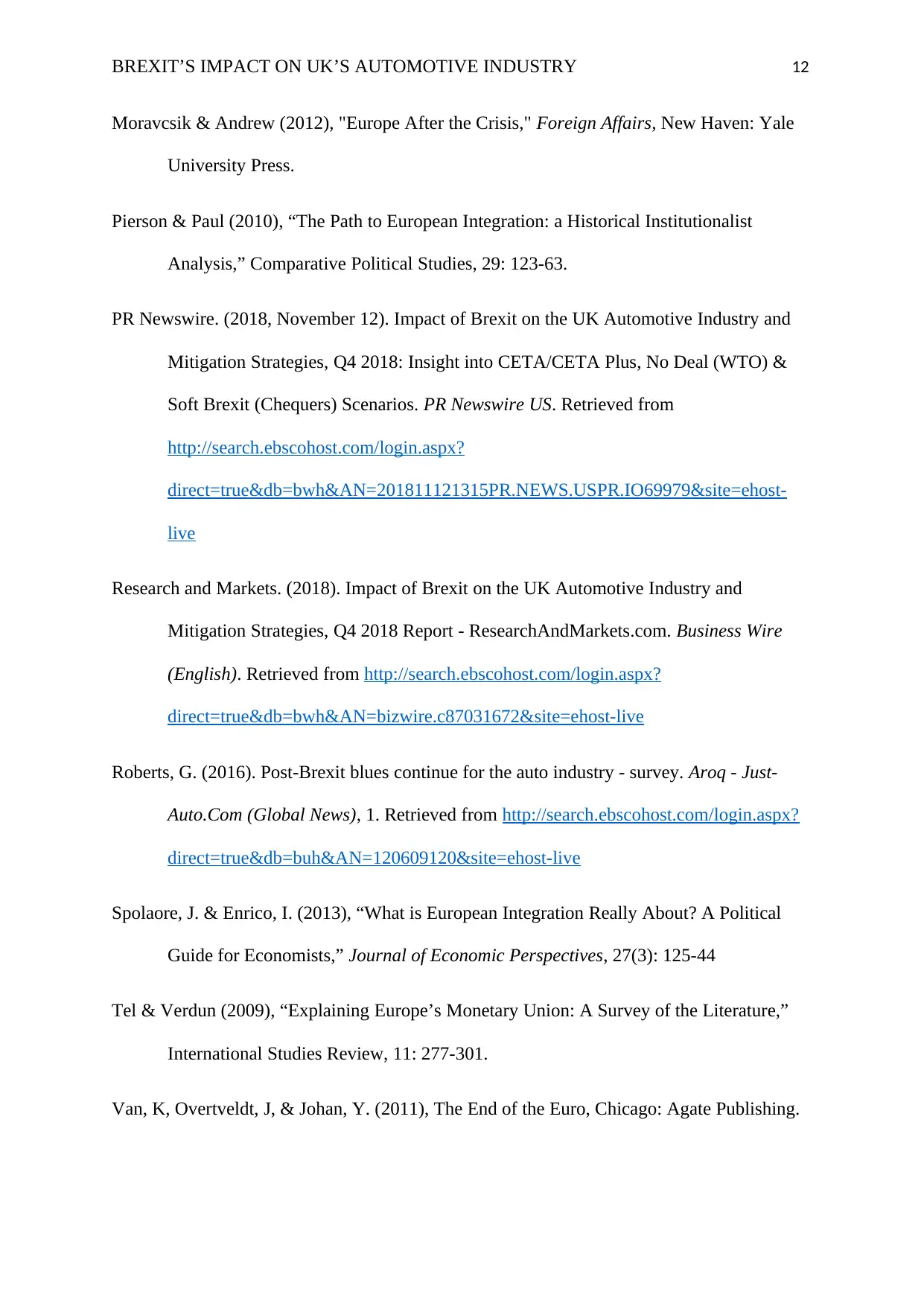
BREXIT’S IMPACT ON UK’S AUTOMOTIVE INDUSTRY 12
Moravcsik & Andrew (2012), "Europe After the Crisis," Foreign Affairs, New Haven: Yale
University Press.
Pierson & Paul (2010), “The Path to European Integration: a Historical Institutionalist
Analysis,” Comparative Political Studies, 29: 123-63.
PR Newswire. (2018, November 12). Impact of Brexit on the UK Automotive Industry and
Mitigation Strategies, Q4 2018: Insight into CETA/CETA Plus, No Deal (WTO) &
Soft Brexit (Chequers) Scenarios. PR Newswire US. Retrieved from
http://search.ebscohost.com/login.aspx?
direct=true&db=bwh&AN=201811121315PR.NEWS.USPR.IO69979&site=ehost-
live
Research and Markets. (2018). Impact of Brexit on the UK Automotive Industry and
Mitigation Strategies, Q4 2018 Report - ResearchAndMarkets.com. Business Wire
(English). Retrieved from http://search.ebscohost.com/login.aspx?
direct=true&db=bwh&AN=bizwire.c87031672&site=ehost-live
Roberts, G. (2016). Post-Brexit blues continue for the auto industry - survey. Aroq - Just-
Auto.Com (Global News), 1. Retrieved from http://search.ebscohost.com/login.aspx?
direct=true&db=buh&AN=120609120&site=ehost-live
Spolaore, J. & Enrico, I. (2013), “What is European Integration Really About? A Political
Guide for Economists,” Journal of Economic Perspectives, 27(3): 125-44
Tel & Verdun (2009), “Explaining Europe’s Monetary Union: A Survey of the Literature,”
International Studies Review, 11: 277-301.
Van, K, Overtveldt, J, & Johan, Y. (2011), The End of the Euro, Chicago: Agate Publishing.
Moravcsik & Andrew (2012), "Europe After the Crisis," Foreign Affairs, New Haven: Yale
University Press.
Pierson & Paul (2010), “The Path to European Integration: a Historical Institutionalist
Analysis,” Comparative Political Studies, 29: 123-63.
PR Newswire. (2018, November 12). Impact of Brexit on the UK Automotive Industry and
Mitigation Strategies, Q4 2018: Insight into CETA/CETA Plus, No Deal (WTO) &
Soft Brexit (Chequers) Scenarios. PR Newswire US. Retrieved from
http://search.ebscohost.com/login.aspx?
direct=true&db=bwh&AN=201811121315PR.NEWS.USPR.IO69979&site=ehost-
live
Research and Markets. (2018). Impact of Brexit on the UK Automotive Industry and
Mitigation Strategies, Q4 2018 Report - ResearchAndMarkets.com. Business Wire
(English). Retrieved from http://search.ebscohost.com/login.aspx?
direct=true&db=bwh&AN=bizwire.c87031672&site=ehost-live
Roberts, G. (2016). Post-Brexit blues continue for the auto industry - survey. Aroq - Just-
Auto.Com (Global News), 1. Retrieved from http://search.ebscohost.com/login.aspx?
direct=true&db=buh&AN=120609120&site=ehost-live
Spolaore, J. & Enrico, I. (2013), “What is European Integration Really About? A Political
Guide for Economists,” Journal of Economic Perspectives, 27(3): 125-44
Tel & Verdun (2009), “Explaining Europe’s Monetary Union: A Survey of the Literature,”
International Studies Review, 11: 277-301.
Van, K, Overtveldt, J, & Johan, Y. (2011), The End of the Euro, Chicago: Agate Publishing.
⊘ This is a preview!⊘
Do you want full access?
Subscribe today to unlock all pages.

Trusted by 1+ million students worldwide
1 out of 15
Related Documents
Your All-in-One AI-Powered Toolkit for Academic Success.
+13062052269
info@desklib.com
Available 24*7 on WhatsApp / Email
![[object Object]](/_next/static/media/star-bottom.7253800d.svg)
Unlock your academic potential
Copyright © 2020–2025 A2Z Services. All Rights Reserved. Developed and managed by ZUCOL.





